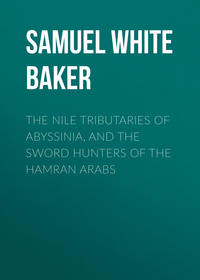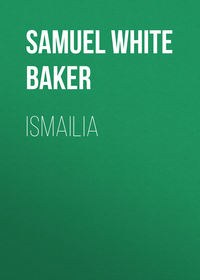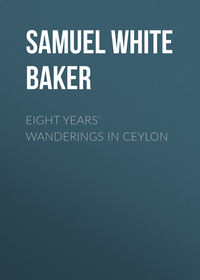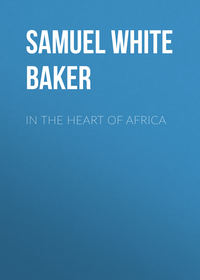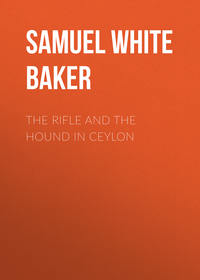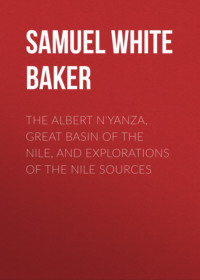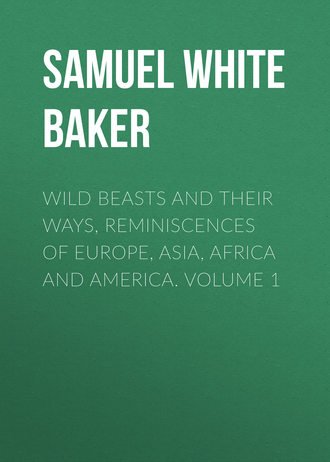 полная версия
полная версияWild Beasts and Their Ways, Reminiscences of Europe, Asia, Africa and America. Volume 1
Presently there was a commotion among the elephants, two or three shrill trumpets, then the kettle-drum, and for a moment I caught sight of a dim shadowy figure stealing through some high reeds upon the border which fringed the jungle. I immediately fired, although the elephant was so unsteady that I could not be sure of the shot; also the object was so indistinct, being concealed in the high reeds, that I should not have observed it upon any other occasion than our rigid search. Immediately afterwards, a shout from one of the mahouts upon a scouting elephant informed us that the tiger had crossed the path and had gone forward, having thus escaped from the beat!
Here was fresh work cut out! Up to this moment we had managed to keep him within an area of a quarter of a mile in length, by half a mile in width; he had now got into new ground, and was in about a three-quarter mile length of the same unbeaten jungle.
There was nothing else to do but to pursue the same tactics, and we patiently continued to beat forward and backward, again and again, but without once sighting our lost game. It was half-past twelve, and the sun was burning hot, the sky being cloudless. The elephants once more emerged from the sultry jungle; they were blowing spray with their trunks upon their flanks, from water sucked up from their stomachs; and the mahouts were all down-hearted and in despair. "It's of no use," they said, "he's gone straight away, who can tell where? When you fired, perhaps you wounded him, or you missed him; at any rate, he's frightened and gone clean off, we shall never see him again; the elephants are all tired with the extreme heat, and we had better go to the river for a bath."
I held a council of war, with the elephants in a circle around me. It is of no use to oppose men when they are disgusted, you must always start a new idea. I agreed with my men, but I suggested that as we were all hot, and the elephants fatigued, the tiger must be in much the same state, as we had kept him on the run since eight o'clock in the morning, I having actually timed the hour "half-past eight" when he charged out of the last corner. "Now," said I, "do you remember that yesterday evening I killed a buck near some water in a narrow depression in the middle of tamarisk jungle? I believe that is only a continuation of this horrible thicket, and if the tiger is nearly played out, he would naturally make for the water and the cool tamarisk. You form in line in the jungle here, and give me a quarter of an hour's start, while I go ahead and take up my position by that piece of water. You then come on, and if the tiger is in the jungle, he will come forward towards the water, where I shall meet him; if he's not there, we shall anyhow be on our direct route, and close to our camp by the river."
This was immediately accepted, and leaving the elephants to form line, I hurried forward on Nielmonne, keeping in the grass outside the edge of the long jungle.
I had advanced about three-quarters of a mile, when the character of the jungle changed to tamarisk, and I felt certain that I was near the spot of yesterday. I accordingly ordered the mahout to turn into the thick feathery foliage to the left, in search of the remembered water. There was a slight descent to a long but narrow hollow about 50 or 60 yards wide; this was filled with clear water for an unknown length.
I was just about to make a remark, when, instead of speaking, I gently grasped the mahout by the head as I leaned over the howdah, and by this signal stopped the elephant.
There was a lovely sight, which cheered my heart with that inexpressible feeling of delight which is the reward for patience and hard work. About 120 yards distant on my left, the head and neck of a large tiger, clean and beautiful, reposed above the surface, while the body was cooling, concealed from view. Here was our friend enjoying his quiet bath, while we had been pounding away up and down the jungles which he had left.
The mahout, although an excellent man, was much excited. "Fire at him," he whispered.
"It is too far to make certain," I replied in the same undertone.
"Your rifle will not miss him; fire, or you will lose him. He will see us to a certainty and be off. If so, we shall never see him again," continued Fazil, the mahout.
"Hold your tongue," I whispered. "He can't see us, the sun is at our back, and is shining in his eyes – see how green they are."
At this moment of suspense the tiger quietly rose from his bath, and sat up on end like a dog. I never saw such a sight. His head was beautiful, and the eyes shone like two green electric lights, as the sun's rays reflected from them, but his huge body was dripping with muddy water, as he had been reclining upon the alluvial bottom.
"Now's the time," whispered the over-eager mahout. "You can kill him to a certainty. Fire, or he'll be gone in another moment."
"Keep quiet, you fool, and don't move till I tell you." For quite a minute the tiger sat up in the same position; at last, as though satisfied that he was in safety and seclusion, he once more lay down with only the head and neck exposed above the surface.
"Back the elephant gently, but do not turn round," I whispered. Immediately Nielmonne backed through the feathery tamarisk without the slightest sound, and we found ourselves outside the jungle. We could breathe freely.
"Go on now, quite gently, till I press your head; then turn to the right, descending through the tamarisk, till I again touch your puggery" (turban).
I counted the elephant's paces as she moved softly parallel with the jungle, until I felt sure of my distance. A slight pressure upon the mahout's head, and Nielmonne turned to the right. The waving plumes of the dark-green tamarisk divided as we gently moved forward, and in another moment we stopped. There was the tiger in the same position, exactly facing me, but now about 75 paces distant.
"Keep the elephant quite steady," I whispered; and, sitting down upon the howdah seat, I took a rest with the rifle upon the front bar of the gun-rack. A piece of tamarisk kept waving in the wind just in front of the rifle, beyond my reach. The mahout leaned forward and gently bent it down. Now, all was clear. The tiger's eyes were like green glass. The elephant for a moment stood like stone. I touched the trigger.
There was no response to the loud report of 6 drams of powder from the '577 rifle, no splash in the unbroken surface of the water. The tiger's head was still there, but in a different attitude, one-half below the surface, and only one cheek, and one large eye still glittering like an emerald, above.
"Run in quick,"–and the order was instantly obeyed, as Nielmonne splashed through the pool towards the silent body of the tiger. There was not a movement of a muscle. I whistled loud, then looked at my watch–on the stroke of 1 P.M. From 8.30 till that hour we had worked up that tiger, and although there was no stirring incident connected with him, I felt very satisfied with the result.
In a short time the elephants arrived, having heard the shot, followed by my well-known whistle. Moota Gutche was the first to approach; and upon observing the large bright eye of the tiger above water, he concluded that it was still alive; he accordingly made a desperate charge, and taking the body on his tusks, he sent it flying some yards ahead; not content with this display of triumph, he followed it up, and gave it a football-kick that lifted it clean out of the water. This would have quickly ended in a war-dance upon the prostrate body, that would have crushed it and destroyed the skin, had not the mahout, with the iron driving-hook, bestowed some warning taps upon the crown of Moota Gutche's head that recalled him to a calmer frame of mind. A rope was soon made fast to the tiger's neck, and Moota Gutche hauled it upon dry ground, where it was washed as well as possible, and well scrutinized for a bullet-hole.
There was no hole whatever in that tiger. The bullet having entered the nostril, broken the neck, and run along the body, the animal consequently had never moved. The first shot, when obscured in thick jungle, had probably deflected from the interposing reeds–at all events it missed. This tiger, when laid out straight, but without being pulled to increase its length, measured exactly 9 feet 8 inches from nose to tail.
CHAPTER III
THE ELEPHANT (continued)The foregoing chapter is sufficient to explain the ferocity of the male elephant at certain seasons which periodically affect the nervous system. It would be easy to multiply examples of this cerebral excitement, but such repetitions are unnecessary. The fact remains that the sexes differ materially in character, and that for general purposes the female is preferred in a domesticated state, although the male tusker is far more powerful, and when thoroughly trustworthy is capable of self-defence against attack, and of energy in work that would render it superior to the gentler but inferior female. (The female differs from other quadrupeds in the position of her teats, which are situated upon the breast between the fore legs. She is in the habit of caressing her calf with her trunk during the operation of suckling.)
It may be inferred that a grand specimen of a male elephant is of rare occurrence. A creature that combines perfection of form with a firm but amiable disposition, and is free from the timidity which unfortunately distinguishes the race, may be quite invaluable to any resident in India. The actual monetary value of an elephant must of necessity be impossible to decide, as it must depend upon the requirements of the purchaser and the depth of his pocket. Elephants differ in price as much as horses, and the princes of India exhibit profuse liberality in paying large sums for animals that approach their standard of perfection.
The handsomest elephant that I have ever seen in India belongs to the Rajah of Nandgaon, in the district bordering upon Reipore. I saw this splendid specimen among twenty others at the Durbar of the Chief Commissioner of the Central Provinces in December 1887, and it completely eclipsed all others both in size and perfection of points. The word "points" is inappropriate when applied to the distinguishing features of an elephant, as anything approaching the angular would be considered a blemish. An Indian elephant to be perfect should be 9 feet 6 inches in perpendicular height at the shoulder. The head should be majestic in general character, as large as possible,—especially broad across the forehead, and well rounded. The boss or prominence above the trunk should be solid and decided, mottled with flesh-coloured spots; these ought to continue upon the cheeks, and for about three feet down the trunk. This should be immensely massive; and when the elephant stands at ease, the trunk ought to touch the ground when the tip is slightly curled. The skin of the face should be soft to the touch, and there must be no indentations or bony hollows, which are generally the sign of age. The ears should be large, the edges free from inequalities or rents, and above all they ought to be smooth, as though they had been carefully ironed. When an elephant is old, the top of the ear curls, and this symptom increases with advancing years. The eyes should be large and clear, the favourite colour a bright hazel. The tusks ought to be as thick as possible, free from cracks, gracefully curved, very slightly to the right and left, and projecting not less than three feet from the lips. The body should be well rounded, without a sign of any rib. The shoulders must be massive with projecting muscular development; the back very slightly arched, and not sloping too suddenly towards the tail, which should be set up tolerably high. This ought to be thick and long, the end well furnished with a double fringe of very long thick hairs or whalebone-looking bristles. The legs should be short in proportion to the height of the animal, but immensely thick, and the upper- portion above the knee ought to exhibit enormous muscle. The knees should be well rounded, and the feet be exactly equal to half the perpendicular height of the elephant when measured in their circumference, the weight pressing upon them whilst standing.
The skin generally ought to be soft and pliable, by no means tight or strained, but lying easily upon the limbs and body.
An elephant which possesses this physical development should be equal in the various points of character that are necessary to a highly-trained animal.
When ordered to kneel, it should obey instantly, and remain patiently upon the ground until permitted to rise from this uneasy posture. In reality the elephant does not actually kneel upon its fore knees, but only upon those of the hinder legs, while it pushes its fore legs forward and rests its tusks upon the ground. This is a most unnatural position, and is exceedingly irksome. Some elephants are very impatient, and they will rise suddenly without orders while the ladder is placed against their side for mounting. Upon one occasion a badly-trained animal jumped up so suddenly that Lady Baker, who had already mounted, was thrown off on one side, while I, who was just on the top of the ladder, was thrown down violently upon the other. A badly-tutored elephant is exceedingly dangerous, as such vagaries are upon so large a scale that a fall is serious, especially should the ground be stony.
A calm and placid nature free from all timidity is essential. Elephants are apt to take sudden fright at peculiar sounds and sights. In travelling through a jungle path it is impossible to foretell what animals may be encountered on the route. Some elephants will turn suddenly round and bolt, upon the unexpected crash of a wild animal startled in the forest. The scent or, still worse, the roar of a bear within 50 yards of the road will scare some elephants to an extent that will make them most difficult of control. The danger may be imagined should an elephant absolutely run away with his rider in a dense forest; if the unfortunate person should be in a howdah he would probably be swept off and killed by the intervening branches, or torn to shreds by the tangled thorns, many of which are armed with steel-like hooks.
It is impossible to train all elephants alike, and very few can be rendered thoroughly trustworthy; the character must be born in them if they are to approach perfection.
Our present perfect example should be quite impassive, and should take no apparent notice of anything, but obey his mahout with the regularity of a machine. No noise should disturb the nerves, no sight terrify, no attack for one moment shake the courage; even the crackling of fire should be unheeded, although the sound of high grass blazing and exploding before the advancing line of fire tries the nerves of elephants more than any other danger.
An elephant should march with an easy swinging pace at the rate of 5 miles an hour, or even 6 miles within that time upon a good flat road. As a rule, the females have an easier pace than the large males. When the order to stop is given, instead of hesitating, the elephant should instantly obey, remaining rigidly still without swinging the head or flapping the ears, which is its inveterate and annoying habit. The well-trained animal should then move backward or forward, either one or several paces, at a sign from the mahout, and then at once become as rigid as a rock.
Should the elephant be near a tiger, it will generally know the position of the enemy by its keen sense of smell. If the tiger should suddenly charge from some dense covert with the usual short but loud roars, the elephant ought to remain absolutely still to receive the onset, and to permit a steady aim from the person in the howdah. This is a very rare qualification, but most necessary in a good shikar elephant. Some tuskers will attack the tiger, which is nearly as bad a fault as running in the opposite direction; but the generality, even if tolerably steady, will swing suddenly upon one side, and thus interrupt the steadiness of aim.
The elephant should never exercise its own will, but ought to wait in all cases for the instructions of the mahout, and then obey immediately.
Such an animal, combining the proportions and the qualities I have described, might be worth in India about / 1500 to any Indian Rajah, but there may be some great native sportsmen who would give double that amount for such an example of perfection, which would combine the beauty required for a state elephant, with the high character of a shikar animal.
Native princes and rajahs take a great pride in the trappings of their state elephants, which is exhibited whenever any pageant demands an extraordinary display. I have seen cloths of silk so closely embroidered with heavy gold as to be of enormous value, and so great a weight that two men could barely lift them. Such cloths may have been handed down from several generations, as they are seldom used excepting in the state ceremonies which occur at distant intervals. A high caste male elephant in its gold trappings, with head-piece and forehead lap equally embroidered, and large silver bells suspended from its tusks, is a magnificent object during the display attending a durbar. At such an occasion there may be a hundred elephants all in their finery, each differing from the other both in size and in the colours of their surroundings.
The outfit for an elephant depends upon the work required. The first consideration is the protection of the back. Although the skin appears as though it could resist all friction, it is astonishing how quickly a sore becomes established, and how difficult this is to heal. The mahouts are exceedingly careless, and require much supervision; the only method to ensure attention is to hold them responsible and to deduct so many rupees from their pay should the backs of their animals be unsound.
With proper care an elephant ought never to suffer, as the pad should be made to fit its figure specially. The usual method is to cover the back from the shoulders to the hips with a large quilted pad stuffed with cotton, about 2 1/2 inches thick. In my opinion, wool is preferable to cotton, and, instead of this coverlet being compact, there should be an opening down the centre, to avoid all pressure upon the spine. A quilted pad stuffed with wool, 3 inches thick, with an opening down the middle, would rest comfortably upon the animal's back, and would entirely relieve the highly-arched backbone, which would thus be exposed to a free current of air, and would remain hard instead of becoming sodden through perspiration. Upon this soft layer the large pad is fixed. This is made of the strongest sacking, stuffed as tight as possible with dried reeds of a tough variety that is common in most tanks; this is open in the centre and quite a foot thick at the sides, so that it fills up the hollow, and rests the weight upon the ribs at a safe distance from the spine.
There are various contrivances in the shape of saddles. The ordinary form for travelling is the char-jarma; this is an oblong frame, exceedingly strong, which is lashed upon the pad secured by girths. It is stuffed with cotton, and neatly covered with native cloth. A stuffed back passes down the centre like a sofa, and two people on either side sit dos-a-dos, as though in an Irish car. Iron rails protect the ends, and swing foot-boards support the feet. This is, in my opinion, the most comfortable way of riding, but some care is necessary in proportioning the weights to ensure a tolerable equilibrium, otherwise, should the route be up and down steep nullahs, the char-jarma will shift upon one side, and become most disagreeable to those who find themselves on the lower level. Natives prefer a well-stuffed pad, as they are accustomed to sit with their legs doubled up in a manner that would be highly uncomfortable to Europeans. Such pads are frequently covered with scarlet cloth and gold embroidery, while the elephant is dressed in a silk and gold cloth reaching to its knees. The face and head are painted in various colours and devices, exhibiting great taste and skill on the part of the designer. It is curious to observe the dexterity with which an otherwise ignorant mahout will decorate the head of his animal by drawing most elaborate curves and patterns, that would tax the ability of a professional artist among Europeans.
The howdah is the only accepted arrangement for sporting purposes, and much attention is necessary in its construction, as the greatest strength should be combined with lightness. There ought to be no doors, as they weaken the solidity of the whole. The weight of a good roomy howdah should not exceed two hundredweight, or at the outside 230 pounds. It must be remembered that the howdah is not adapted for travelling, as there is a disagreeable swinging motion inseparable from its position upon the elephant's back which is not felt upon either the pad or the char-jarma. The howdah is simply for shooting, as you can fire in any direction, which is impossible from any other contrivance where the rider sits in a constrained position.
A good howdah should be made of exceedingly strong and tough wood for the framework, dovetailed, and screwed together, the joints being specially secured by long corner straps of the best iron. The frame ought to be panelled with galvanised wire of the strongest description, the mesh being one-half inch. The top rail, of a hard wood, should be strengthened all around the howdah by the addition of a male bamboo 1 1/2 inch in diameter, securely lashed with raw hide, so as to bind the structure firmly together, and to afford a good grip for the hand. As the howdah is divided into two compartments, the front being for the shooter, and the back part for his servant, the division should be arranged to give increased strength to the construction by the firmness of the cross pieces, which ought to bind the sides together in forming the middle seat; the back support of which should be a padded shield of thick leather, about 15 inches in diameter, secured by a broad strap of the same material to buckles upon the sides. This will give a yielding support to the back of the occupant when sitting. The seat should lift up, and be fitted as a locker to contain anything required; and a well-stuffed leather cushion is indispensable. The gun-rack should be carefully arranged to contain two guns upon the left, and one upon the right of the sitter. These must be well and softly padded, to prevent friction. The floor should be covered either with thick cork or cork-matting to prevent the feet from slipping.
It must be remembered that a howdah may be subjected to the most severe strain, especially should a tiger spring upon the head of an elephant, and the animal exert its prodigious strength to throw off its assailant. The irons for fastening the girths should therefore be of the toughest quality, and, instead of actual girths, only thick ropes of cotton ought to be used. A girth secured with a buckle is most dangerous, as, should the buckle give way, an accident of the most alarming kind must assuredly occur. The howdah ought to be lashed upon the elephant by six folds of the strong cotton rope described, tightened most carefully before starting. It should be borne in mind that much personal attention is necessary during this operation, as the natives are most careless. Two or three men ought to sit in the howdah during the process of lacing, so as to press it down tightly upon the pad, otherwise it will become loose during the march, and probably lean over to one side, which is uncomfortable to both man and beast. A large hide of the sambur deer, well cured and greased so as to be soft and pliable, should, invariably protect the belly of the elephant, and the flanks under the fore legs, from the friction of the girthing rope. The breastplate and crupper also require attention. These ought to be of the same quality of cotton rope as used for the girths, but that portion of the crupper which passes beneath the tail should pass through an iron tube bent specially to fit, like the letter V elongated, U. This is a great safeguard against galling, and I believe it was first suggested by Mr. G. P. Sanderson.
A fine male elephant, well accoutred with his howdah thoroughly secured, and a good mahout, is a splendid mount, and the rider has the satisfaction of feeling that his animal is well up to his weight. I do not know a more agreeable sensation than the start in the early morning upon a thoroughly dependable elephant, with all the belongings in first-rate order, and a mahout who takes a real interest in his work; a thorough harmony exists between men and beast, the rifles are in their places, and you feel prepared for anything that may happen during the hazardous adventures of the day.




